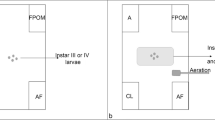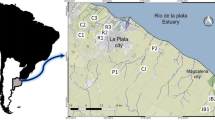Abstract
The chironomid fauna living on an exotic macrophyte, Eurasian water milfoil (Myriophyllum spicatum), was studied quantitatively for a year in experimental ponds constructed to simulate reservoir wetlands. A total of 10 species, 2 Orthocladiinae, 5 Chironominae, and 3 Tanypodinae, were recorded. Of these 10 chironomid species, Apedilum elachistum comprised 79% of all chironomid larvae collected on the plants. Annual production of A. elachistum was estimated by the size-frequency method to be 9.9 g dry mass/m2/yr for milfoil surface area, which is among the highest production estimates reported for a single species. Annual production/biomass was 79/yr. Laboratory-reared larvae required an average of 23 days at 15°, 16 days at 20°, and 11 days at 25 °C to complete their development from first instar to imago.
Similar content being viewed by others
Literature cited
Aiken, S. G., P. R. Newroth, and I. Wile. 1979. The biology of Canadian weeds. 34. Myriophyllum spicatum L. Canadian Journal of Plant Science 59:201–215.
Balci, P. and J. H. Kennedy. 2002. Egg to adult development times of five species of chironomids. Entomological News 113:21–24.
Bay, E. C. 1974. Predator-prey relationships among aquatic insects. Annual Review of Entomology 19:441–492.
Beckett, D. C., T. P. Aartila, and A. C. Miller. 1992. Invertebrate abundance on Potamogeton nodosus: effects of plant surface area and condition. Canadian Journal of Zoology 70:300–306.
Benke, A. C. 1976. Dragonfly production and prey turnover. Ecology 57:915–927.
Benke, A. C. 1979. A modification of the Hynes method for estimating secondary production with particular significance for multivoltime populations. Limnology and Oceanography 24:168–171.
Benke, A. C. 1984. Secondary production of aquatic insects. p. 289–322. In V. H. Resh and D. M. Rosenberg (eds.) The Ecology of Aquatic Insects. Praeger, New York, NY, USA.
Benke, A. C. 1993. Concepts and patterns of invertebrate production in running waters. Verhandlungen Internationale Vereinigung Limnologie 25:15–38.
Benke, A. C. 1998. Production dynamics of riverine chironomids: Extremely high biomass turnover rates of primary consumers. Ecology 79:899–910.
Benke, A. C., T. C. Van Arsdall, and D. M. Gillespie. 1984. Invertebrate productivity in a subtropical blackwater river: the importance of habitat and life history. Ecological Monographs 54:25–63.
Benke, A. C. and J. R. Wallace. 1980. Trophic basis of production among netspinning caddisflies in a southern Appalachian stream. Ecology 61:108–118.
Benson, D. J., L. C. Fitzpatrick, and W. D. Pearson. 1980. Production and energy flow in the benthic community of a Texas pond. Hydrobiologia 74:81–93.
Berg, B. and R. A. Hellenthal. 1991. Secondary production of Chironomidae (Diptera) in a north temperate stream. Freshwater Biology 25:497–505.
Cattaneo, A. and J. Kalff. 1980. The relative contribution of aquatic macrophytes and their epiphytes to the production of macrophyte beds. Limnology and Oceanography 25:280–289.
Crowder, L. B. and W. E. Cooper. 1982. Habitat structural complexity and the interaction between bluegills and their prey. Ecology 63:1802–1813.
Cyr, H. and J. A. Downing. 1988. The abundance of phytophilious in vertebrates on different species of submerged macrophytes. Freshwater Biology 20:365–374.
Darby, R. E. 1962. Midges associated with California rice fields, with special reference to their ecology (Diptera: Chironomidae). Hilgardia 32:1–206.
Dibble, E. D. and S. L. Harrel. 1997. Largemouth bass diets in two aquatic plant communities. Journal of Aquatic Plant Management 35:74–78.
Dvorak, J. and E. P. H. Best. 1982. Macro-invertebrate communities associated with the macrophytes of Lake Vechten: Structural and functional relationships. Hydrobiologia 95:115–126.
Entrekin, S. A., S. W. Golladay, and D. P. Batzer. 2001. The influence of plant community on chironomid secondary production in two wetland-types: cypress gum-swamps and grass-sedge marshes. Archiv für Hydrobiologie 152:364–394.
Epler, J. H. 1988. A reconsideration of the genus Apedilum Townes. 1945. Spixiana 14:105–116.
Grzybkowska, M. and J. Witczak. 1990. Distribution and production of Chironomidae (Diptera) in the lower course of the Grabia River (Central Poland). Freshwater Biology 24:519–531.
Hauer, F. R. and A. C. Benke. 1991. Rapid growth rates of snagdwelling chironomids in a blackwater river: the influence of temperature and discharge. Journal of North American Benthological Society 10:154–164.
Honnell, D. R., J. D. Madsen, and R. M. Smart. 1993. Effects of selected exotic and native aquatic plant communities on water temperature and dissolved oxygen. U.S. Army Corp of Engineers Waterway Experiment Station, Vicksburg, MS, USA. A-93-2.
Keast, A. 1984. The introduced aquatic macrophyte, Myriophyllum spicatum, as habitat for fish and their invertebrate prey. Canadian Journal of Zoology 62:1289–1303.
Krecker, F. H. 1939. A comparative study of the animal population of certain submerged aquatic plants. Ecology 20:553–562.
Krull, J. N. 1970. Aquatic plant-macroin vertebrate associations and waterfowl. Journal of Wildlife Management 34:707–718.
Kowalczewski, A. 1975. Periphyton primary production in the zone of submerged vegetation of Mikolajskie Lake. Ekologia Polska 23:509–543.
Leeper, D. A. and B. E. Taylor. 1998. Abundance, biomass and production of aquatic invertebrates in Rainbow Bay, a temporary wetland in South Carolina, USA. Archiv für Hydrobiologie 143: 335–362.
LeSage, L. and A. D. Harrison. 1979. Improved traps and techniques for the study of emerging aquatic insects. Entomological News 90:65–78.
Lindegaard, C. and E. Mortensen. 1988. Abundance, life history and production of Chironomidae (Diptera) in a Danish lowland stream. Archiv für Hydrobiologie 81:563–587.
Mackey, A. P. 1977a. Quantitative studies on the Chironomidae (Diptera) of the River Thames and Kennet. III. The Nuphar zone. Archiv für Hydrobiologie 79:62–102.
Mackey, A. P. 1977b. Growth and development of larval Chironomidae. Oikos 28:270–275.
Menzie, C. A. 1980. The Chironomid (Insecta: Diptera) and other fauna of a Myriophyllum spicatum L. plant bed in the Lower Hudson River. Estuaries 3:38–54.
Menzie, C. A. 1981. Production ecology of Cricotopus sylvestris (Fabricius) (Diptera: Chironomidae) in a shallow estuarine cove. Limnology and Oceanography 26:467–481.
Nolte, U. 1995. From egg to imago in less than seven days: Apedilum elachistum (Chironomidae). p. 177–184. In P. Cranston (ed.) Chironomids: From genes to ecosystems. CSIRO Publications, Collingwood, Australia.
Oliver, D. R., M. E. Dillon, and P. S. Cranston. 1990. A catalog of Nearctic Chironomidae. Publications of the Research Branch, Agriculture, Ottawa, ON, Canada.
Pardue, W. J. and D. H. Webb. 1985. A comparison of aquatic macroin vertebrates occurring in association with Eurasian milfoil (Myriophyllum spicatum L.) with those found in the open littoral zone. Journal of Freshwater Ecology 3:69–79.
Peets, R., A. C. Miller, and D. C. Beckett. 1994. Effects of three species of aquatic plants on macroin vertebrates in Lake Seminole, Georgia. U.S. Army Corp of Engineers Waterway Experiment Station, Vicksburg, MS, USA. A-94-5.
Sephton, T. W. and C. G. Paterson. 1986. Production of the chironomid Procladius bellus in an annual drawdown reservoir. Freshwater Biology 16:721–733.
Sher-Kaul, S., B. Oertli, E. Castella, and J. B. Lachavanne. 1995. Relationship between biomass and surface area of six submerged aquatic plant species. Aquatic Botany 51:147–154.
Soszka, G. J. 1975. The invertebrates on submerged macrophytes in three Masurian lakes. Ekologia Polska 23:371–391.
Spies, M. and F. Reiss. 1996. Catalog and bibliography of Neotropical and Mexican Chironomidae. Spixiana Supplement 22:61–119.
Stites, D. L. and A. C. Benke. 1989. Rapid growth rates of chironomids in three habitats of a subtropical blackwater river and their implications for P/B ratios. Limnology and Oceanography 34: 1278–1289.
Tokeshi, M. 1986. Population dynamics, life histories and species richness in an epiphytic chironomid community. Freshwater Biology 16:431–441.
Tokeshi, M. 1995. Life cycles and population dynamics. p. 225–268. In P. D. Armitage, P. S. Cranston, and L. C. V. Pinder (eds.) The Chironomidae: Biology and Ecology of Non-Biting Midges. Chapman and Hall Publications, London, UK.
United States Geological Survey (USGS). 2000. Non-indigenous aquatic plants, [Online]. Available: http://nas.er.usgs.gov/dicots/ my_spica.html [2000, February 15]
Weldon, L. W., R. D. Blackburn, and D. S. Harrison. 1977. Common Aquatic Weeds. Dover Publications, New York, NY, USA.
Wilda, T. J. 1984. The production of five genera of Chironomidae (Diptera) in Lake Norman, a North Carolina reservoir. Hydrobiologia 108:145–152.
Wissinger, S. A. 1999. Ecology of wetlands invertebrates: synthesis and applications for conservation and management. p. 1043–1087. In D. P. Batzer, R. B. Rader and S. A. Wissinger (eds.) Invertebrates in Freshwater Wetlands of North America: Ecology and Management. John Wiley & Sons, Inc. New York, NY, USA.
Wright, J. R., P. D. Hiley, A. C. Cameron, M. E. Wigham, and A. D. Berrie. 1983. A quantitative study of the macroin vertebrate fauna of five biotopes in the River Lambourn, Berkshire, England. Archiv für Hydrobiologie 96:271–292.
Wrubleski, D. A. 1999. Northern prairie marshes (Delta Marsh, Manitoba): II. Chironomidae (Diptera) responses to changing plant communities in newly flooded habitats. p. 571–603. In D. P. Batzer, R. B. Rader and S. A. Wissinger (eds.) Invertebrates in Freshwater Wetlands of North America: Ecology and Management. John Wiley & Sons, Inc. New York, NY, USA.
Author information
Authors and Affiliations
Rights and permissions
About this article
Cite this article
Balci, P., Kennedy, J.H. Secondary production of Apedilum elachistum townes (Diptera: Chironomidae) in simulated reservoir wetlands. Wetlands 22, 669–676 (2002). https://doi.org/10.1672/0277-5212(2002)022[0669:SPOAET]2.0.CO;2
Received:
Revised:
Accepted:
Issue Date:
DOI: https://doi.org/10.1672/0277-5212(2002)022[0669:SPOAET]2.0.CO;2




